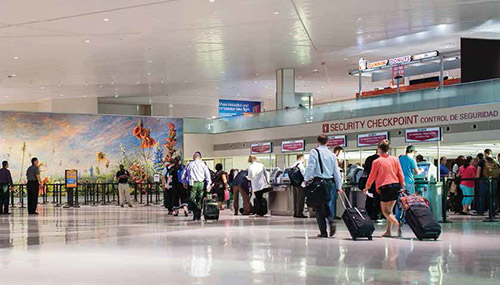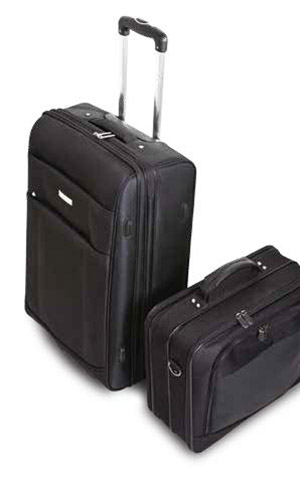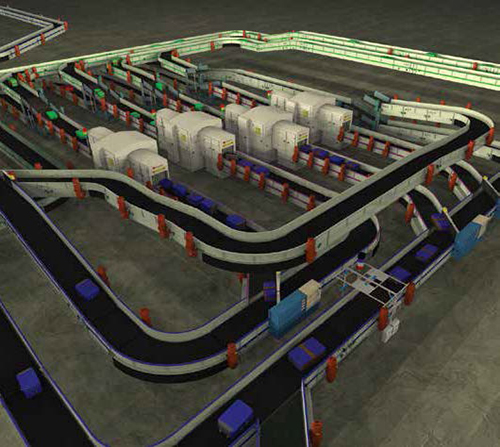Love Field Thinks Outside the Baggage Box With Temporary Bag Claim
 A new baggage handling system designed to accommodate an expected traffic bump at Dallas Love Field Airport (DAL) is a key component of the airport's $500+ million modernization program slated for completion in October.
A new baggage handling system designed to accommodate an expected traffic bump at Dallas Love Field Airport (DAL) is a key component of the airport's $500+ million modernization program slated for completion in October.
Planning for the baggage system began in 2008, in conjunction with the rest of the Love Field Modernization Program, and design work commenced in 2009, chronicles Chris Norton, chief operating officer of Vic Thompson Co.
The initial planning phase involved forecasting to determine the size of the new baggage handling system, adds Jeff Callaghan, project manager with Vic Thompson Co. That included analyzing current and anticipated flight loads and schedules. The Oct. 13 expiration of the Wright Amendment is expected to trigger an increase in enplanements, as the federal legislation previously limited the markets airlines could fly to from DAL.
"We started with the assumption that we're not going to be bigger than 20 gates," Callaghan explains. Based on the type of aircraft using the gates and the forecasted passenger numbers, planners determined that the system would require three screening machines to handle approximately 2,000 bags per hour - a peak hour at DAL.
Saving Time & Money
According to the original schedule for the overall modernization program, renovation of the baggage claim hall would not begin until 2015 - after other major projects were complete. But the project teams collaborated and devised a way to create a temporary baggage claim hall in a different part of the facility. This allowed contractor Hensel Phelps to "go full-boar on the claim hall," Callaghan explains.
Bob Montgomery, vice president of Airport Affairs at Southwest Airlines, estimates that using the temporary baggage facility saved roughly a year in the project schedule. Initially, baggage claim improvements were scheduled to begin after the Wright Amendment expired in mid-October. The original plan was to shut down half of the baggage claim for renovations, while the other half remained in operation. Once the new portion was complete, construction on the other half would begin. "That whole step-by-step process (would have taken) a couple of years," Montgomery relates. However, as the project team analyzed the program, they saw an opportunity to accelerate the process.
Ultimately, crews transformed DAL's former ticket counter and bag makeup area, and modified existing equipment to create a temporary baggage claim. Although the area ended up being larger than planned, it provided better customer service and allowed the project team to move ahead with demolition of the old baggage claim wing at the start of 2013.
|
factsfigures Project: Baggage Handling System Location: Dallas Love Field Airport Owner: City of Dallas Modernization Program Architect & Designer: Corgan Project Manager (on behalf of city of Dallas): Southwest Airlines Construction Manager at Risk: Hensel Phelps Baggage System Design: Vic Thompson Co. Temporary Inbound Baggage System Installation: BEUMER Glidepath Baggage System Installation: Jervis B. Webb Co. Explosive Detection Machines: L3 Outbound Checked Bag Inspection System: 409 motors; 5,700 linear ft. of conveyor; 4 inline screening devices; 3 makeup units Inbound Baggage Handling System: 59 motors; 1,700 linear ft. of conveyor; 4 claim carousels Motors: SEW Eurodrive Power Belt Curves: Transnorm System Noteworthy Detail: Construction of a temporary baggage claim facility using existing equipment accelerated project schedule by 1 year |
"It was a useful way to repurpose that equipment," remarks David Mead, vice president of customer support with BEUMER Glidepath. It would have been easy to purchase new equipment that would have had a limited life, notes Mead. Instead, the team engineered an alternative that allowed the airport to get more value out of its original system.
"That approach of continuously looking for improvement throughout the project really benefited the project and the owner," notes Jonathan Massey, principal with Corgan, the project's lead architect and designer.
The temporary baggage claim will allow the project to be completed in time for the end of the Wright Amendment - a full year ahead of schedule. "In construction, time is money," Montgomery says. "And that turned out to be a great program savings."
Choosing to use the temporary baggage claim was a "hard decision," recalls DAL Airport Director Mark Duebner. Officials knew that moving the facility would inconvenience travelers and the temporary area would be cramped; but they also knew it would save construction time and eventually benefit passengers and the airport.

"When you're doing a big public project like this, you really have to weigh short-term pain for long-term gain," Duebner says. "I think the correct decision was made to go with the temporary bag claim. Although it wasn't ideal, it shortened the duration of the construction and saved money."
New System
DAL's new outbound checked baggage inspection system, which has been operating since November 2012, includes four ticket counter inputs and two curbside inputs. The six inputs feed two mainlines that lead to four screening machines; the two mainlines run from the matrix out to the baggage makeup area, which includes three carousels for the airlines.
The outbound portion of the baggage system is similar to what was previously in place for about six years, notes Callaghan. The new system, however, is larger in linear footage (based on the new airport layout) and can process approximately 30% more bags, he adds. The outbound checked bag inspection system includes 409 SEW Eurodrive motors, 5,700 linear feet of conveyor, four inline L3 screening devices and three makeup units.

The screening matrix itself includes the TSA's checked baggage resolution area. It is the first system to use L3's inline screening devices with a capacity of about 700 bags per machine per hour, reports Callaghan. Previous models had a capacity of approximately 500 bags per machine per hour.
The inbound baggage handling system is comprised of 59 SEW Eurodrive motors, 1,700 linear feet of conveyor and four claim carousels. It is scheduled to go live Oct. 1.
The biggest change for the inbound system is the larger, more open baggage claim hall, Callaghan observes. The system will feature four slope-plate claim carousels vs. the four flat-plate carousels of the previous system.
Critical Phasing

Because of the constraints and challenges involved with building a terminal on top of an existing, operating terminal, planners divided the project into multiple phases. Communication was key in keeping stakeholders informed and minimizing impact to operations throughout the program, Norton notes.
Callaghan reports that the planning team reviewed a handful of designs and locations, including a vertical system on multiple levels of the airport. Ultimately, it determined that the basement was the best place for the screening matrix, in relation to the operation. "That opened up a whole other can of worms," he recalls.
Because of previous flooding problems, civil engineers conducted flood plain studies to determine how to best mitigate the situation. Ultimately, the area around the terminal was re-graded, and a system was designed to capture the water and store it for reuse as makeup water for the cooling towers in the building's mechanical system, Massey explains. 
Like phasing, communication was also identified as a critical element of the baggage handling system project. The design and construction teams, along with DAL and Southwest, formed a working committee that met regularly throughout the project. In addition to making sure that temporary measures and conditions worked for passengers, the airport and airlines, Massey notes that the team continuously looked for ways to improve the passenger experience, operations and construction processes.

FREE Whitepaper
PAVIX: Proven Winner for All Airport Concrete Infrastructure
International Chem-Crete Corporation (ICC) manufactures and sells PAVIX, a unique line of crystalline waterproofing products that penetrate into the surface of cured concrete to fill and seal pores and capillary voids, creating a long lasting protective zone within the concrete substrate.
Once concrete is treated, water is prevented from penetrating through this protective zone and causing associated damage, such as freeze-thaw cracking, reinforcing steel corrosion, chloride ion penetration, and ASR related cracking.
This white paper discusses how the PAVIX CCC100 technology works and its applications.








